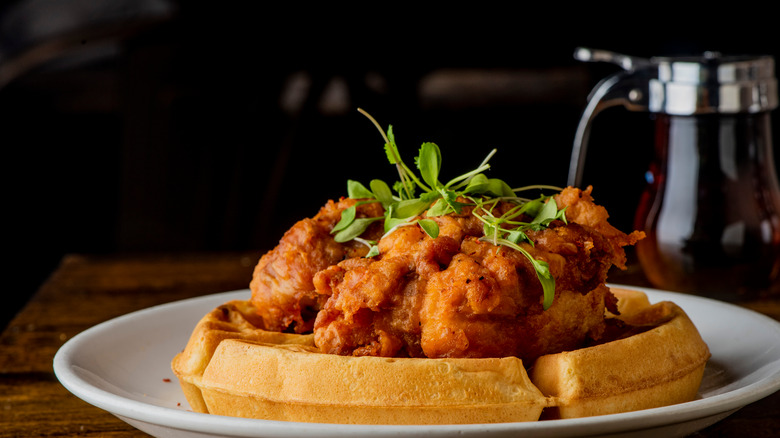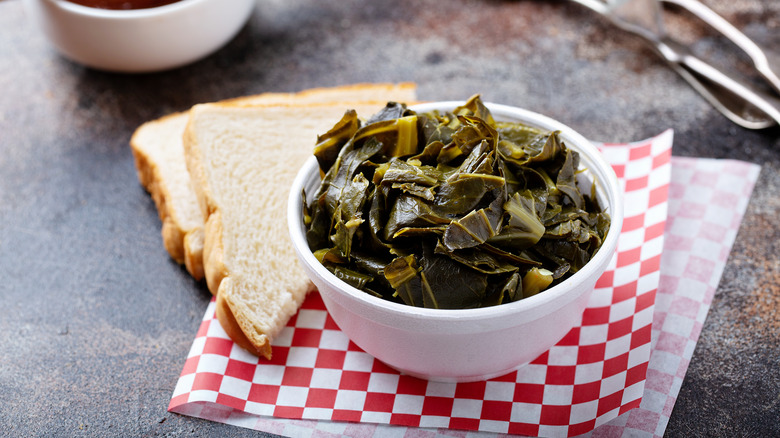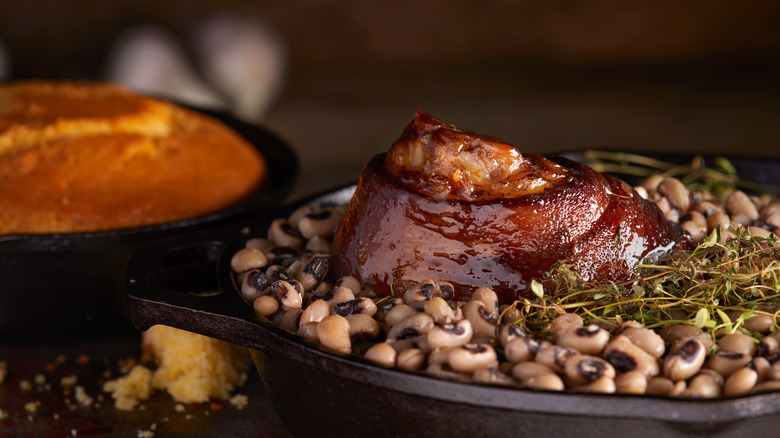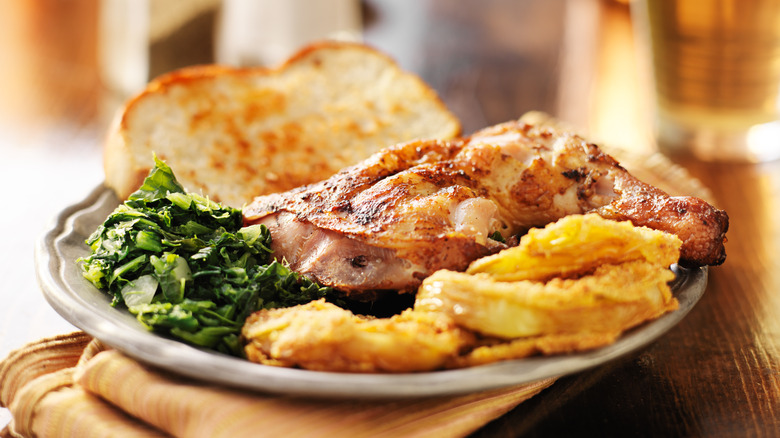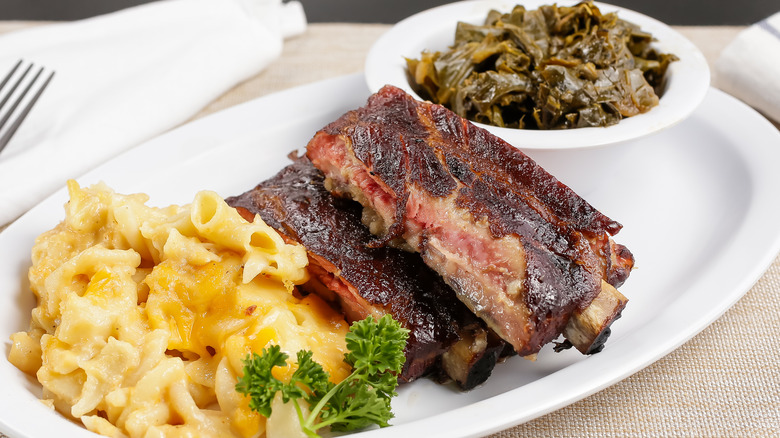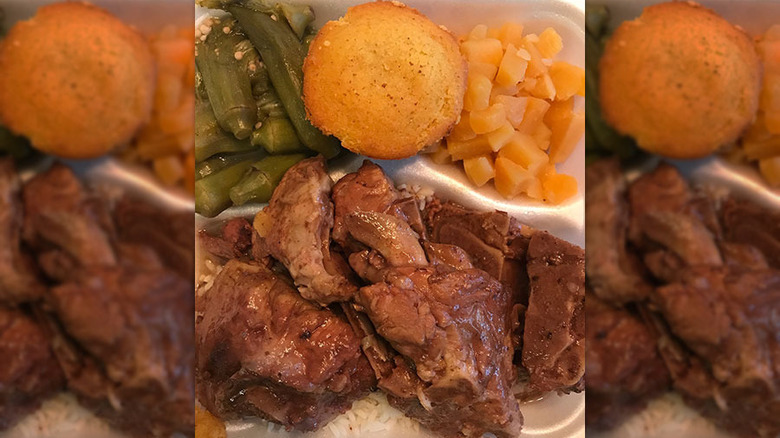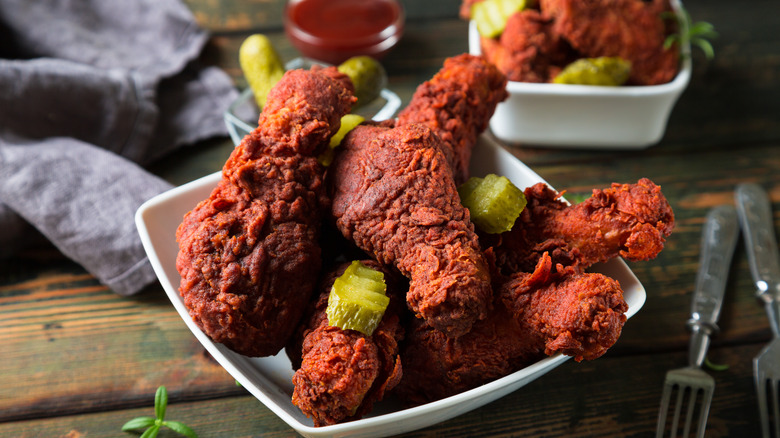The Untold Truth Of Soul Food
For hungry Americans, the words "soul food" conjure up big plates of comfort — think smothered pork chops, fried chicken, greens stewed with smokey ham, and, of course, cornbread. So deeply ingrained is soul food in the American culinary landscape that a typical coffee shop or diner or cafeteria menu would be unrecognizable without it. Can you imagine crossing the country without ever seeing fried chicken, barbequed ribs, or macaroni and cheese?
But as is often the case with Black culture, the innovators who originally created these treats and brought them into the American mainstream remain unnamed and unrecognized. This is in part because of the origins of the cuisine: According to Epicurious, soul food originated with enslaved people doing their best to feed their families with the limited provisions they had available, and over time, generations of creative (but anonymous) cooks turned it into a cuisine that was not only nourishing, but delicious. So delicious, in fact, that the rest of the country embraced it as their own. For this reason, food historian Jessica B. Harris argued in Eater, "African-American food is American food." Here's the surprising — and complicated — story of how soul food came to be.
Defining soul food is surprisingly tricky
Everyone knows what soul food is, right? Loosely defined, it's a cuisine associated with Black American culture. But a closer look at the cuisine itself reveals a more complicated situation: Many of the popular dishes in the soul food canon — including cornbread and fried catfish — are also favorites of white cooks and eaters, especially in the American South, according to Delish. And this raises the question of whether soul food and Southern food are actually distinct cuisines — and if so, what distinguishes one from the other?
Chefs and culinary historians have proposed ways to tease apart the difference. Chef Millie Peartree tells Delish that soul food can actually be considered an expatriate cuisine, brought to the northern U.S. states during the early 20th century, when a large number of southern Blacks moved north for better opportunities.
As for distinguishing it from Southern cuisine more generally, historian Adrian Miller argues that intense spicing is what sets soul food apart. "It's going to have, typically, more fat; it's going to be sweeter, spicier, saltier. A perfect example is Nashville hot chicken, a really super-spicy version of fried chicken. It makes complete sense that this dish comes out of the soul food tradition," he said. Chef Todd Richards agrees. "That strong flavor profile we have — the spice, the smoke, the heat — those didn't come from any English settlers. They were preservation methods that we know were used in Africa long before anyone ever landed in the state of Georgia," he said.
Here's where the term "soul food" came from
While the Black American cooking tradition is centuries old, the term "soul food" is fairly recent, emerging only in the 1960s, with the publication of the essay "Soul Food" by activist and poet Amiri Baraka. In the essay, Baraka argued against the common misconception that there is no distinct African-American cuisine, according to Delish. The term caught on and soon became a point of pride for Black cooks.
The use of the word "soul" as a descriptor for Black culture has deeper roots that go beyond food, however. As historian Adrian Miller tells Epicurious, Black jazz musicians began to use the term in the 1940s to describe the unique flair they brought to their music — a sound that their better-paid and better-treated white peers could rarely duplicate. By the time the term "soul food" had been coined, "soul" had become a blanket term for everything distinctive about Black culture, from music to fashion.
Soul food has African, Native American, and European roots
While soul food was originally created by enslaved Black Americans and their descendants, its roots and influences are global and encompass Native American, European, and African culinary traditions and ingredients — one could easily argue that it's one of America's earliest examples of culinary fusion.
First, enslaved Africans brought their own cooking techniques and food production knowledge with them to North America. For instance, the traditional African practice of boiling leafy greens into a stew to be served with a bland starch translated easily into the soul food tradition of boiling locally available greens — such as collard or mustard greens or kale — with smoked meat and serving it with cornbread, according to Black Foodie.
Black cooks are also responsible for introducing many European dishes into the American diet: As culinary historian Jessica B. Harris notes, we wouldn't have ice cream, French fries, or macaroni and cheese on our menus if it weren't for James Hemings, Thomas Jefferson's enslaved chef, whom Jefferson sent to France for culinary training. Finally, as noted by Global Foodways, Native Americans introduced Black cooks to indigenous North American ingredients such as corn and sweet potatoes — which became among the defining ingredients in soul food.
Classic soul food is hearty and full of flavor
If you're lucky enough to be invited to a traditional soul food dinner, make sure to bring your appetite. A classic soul food meal is meant to nourish. As historian Adrian Miller explains, you can expect not only a meat- or fish-based main dish, such as fried chicken, fried catfish, or chitlins, but several side dishes. One of these will likely be greens (most commonly cabbage, mustard or turnip greens, collards, or kale), which will be stewed until tender with meat. You can probably also expect starchy favorites such as macaroni and cheese or candied yams, along with cornbread, and, to add a little something extra, hot sauce on the side.
Soul food has a reputation for being rich and fatty, and let's be honest, traditionally made macaroni and cheese isn't exactly diet food. But Miller argues that while soul food — like pretty much all cuisines — has its share of fatty, rib-sticking dishes, overall, it employs more than its share of healthful ingredients for the diet conscious.
"I think let's just back up and think about what nutritionists are telling us to eat these days: more dark, leafy greens more sweet potatoes, more fish," Miller told Duke University's World Food Policy Center. "Okra is a super food now, hibiscus. So all of these things are the building blocks of soul food." Miller recommends enjoying traditional soul food in moderation — and broiling that catfish with Creole spice mix instead of frying it if you're concerned about calories.
When feasting on soul food, save room for dessert
One of the reasons soul food has a reputation as rich and hearty is its repertoire of rib-sticking desserts. Some classic desserts you may expect at the conclusion of a soul food feast include peach cobbler, pecan pie, angel food cake, banana pudding, or sweet potato pie, according to Big 7 Travel. Most of these desserts are also wildly popular on American tables outside the soul food tradition, which raises the question: How did these specific dishes become so closely associated with soul food?
This comes from the history of these dishes and the people who made them. Desserts such as fruit pies and cakes have European roots, as did the plantation owners who had enslaved Black Americans preparing their food, according to Global Foodways. These enslaved people not only mastered the cooking and baking techniques needed to stay in their masters' good graces, but they adapted traditional European recipes to accommodate locally available ingredients.
Sweet potato pie, for instance, has the same color and flavorings as traditional English carrot pie; and banana pudding is a New World variation on an English trifle, according to culinary historian Adrian Miller. And while these treats have become popular among all Americans, they hold a place of honor on soul food tables.
Vegan soul food is a thing — and it's not new
While soul food has a reputation of being rich and meaty, it doesn't have to be. Vegetables have always been an important part of the soul food kitchen, and in pre-industrial times, richer, meatier dishes were considered special-occasion fare, not staples. As Celia Barbour noted in Oprah magazine "It was hard to gorge on fried chicken when you had to first catch, slaughter, gut, and pluck the obstinate bird; quite another matter when it came in a bucket for $6.99."
Today, Barbour said, health-conscious soul food cooks are experimenting with vegetarian and vegan versions of soul food classics, such as greens seasoned with onions, garlic, and herbs instead of ham. While these chefs may see plant-forward soul food as a way to reclaim their cuisine from the clutches of fast-food franchises, Barbour notes it harkens back to much older African culinary traditions: The traditional West African diet — a major influence on the development of soul food — was largely plant-based. "For thousands of years, the traditional West African diet was predominantly vegetarian, centered on things like millet, rice, field peas, okra, hot peppers, and yams. Meat was used sparingly, as a seasoning," Barbour explained.
Here's why chitlins are an iconic soul food dish
Many soul food classics, such as pecan pie and fried catfish, have become so deeply embedded in the American diet that some may forget their soul food roots entirely. This is not the case, however, for chitlins — probably the most contentious dish in the traditional soul food repertoire. Chitlins (or chitterlings) are pork intestines, and their taste and texture are not for everyone — while some people crave them, others won't touch them if you paid them to.
But while chitlins lack the mainstream appeal of more popular soul foods, they remain an emblematic part of the soul food menu. A common theory as to how they gained this place of honor is that historically, Black cooks only had access to cheaper, less-popular cuts of meat, such as pigs' feet and intestines. However, food historian Adrian Miller tells First We Feast this wasn't actually the case for chitlins
"If you look at the history, it was actually a prestige food in Old Europe. The gentry in France and England would eat the intestines after a deer hunt," he said. "There are instances in slave narratives where you come across masters beating slaves because they didn't make it well enough for the master's table. After Emancipation, chitlins eventually loses its prestige factor and is seen more as a poverty food." Still, chitlins never lost their prestige on the soul food table — and remain there to this day.
Red drinks are an essential part of the soul food menu
Have you ever had a cup of punch or a red soft drink and couldn't quite tell if it was cherry or strawberry flavored, or maybe a mixture of several red fruits and perhaps something else? And whatever it was, it still tasted familiar — but the only word you could think of to describe it was "red"? You're not alone. As a matter of fact, you're experiencing part of the soul food tradition of red drinks.
"In the soul-food tradition, we don't get caught up in describing something as cherry, strawberry, or tropical punch — you just say it's red," culinary historian Adrian Miller tells First We Feast. "It's the official soul-food drink, and if a place doesn't offer it in some form, the restaurant is automatically suspect to me."
In short, in soul food dining, red isn't just a color but a flavor. And red drinks have deep roots in the soul food tradition: In West Africa, Miller explains, hibiscus flowers and cola nuts were both used to make drinks, and both of these drinks were red. (The brown coloring in today's carbonated colas comes from food coloring.) Hibiscus flowers and cola nuts came with enslaved Africans to the New World, where the red drink tradition took root. Over time, the soul food table came to embrace other red drinks, including red lemonade (popular in the 19th century), red carbonated soft drinks, and red drinks from powdered mixes.
Traditional soul food restaurants are getting harder to find
While many classic soul food dishes can be easily found on menus across the country, traditional soul food restaurants — typically, mom-and-pop places with bare-bones décor in historically Black neighborhoods — are getting harder to find, as noted by The GW Hatchet. According to The New York Times, rising rents and food costs, gentrification, changing tastes, and concerns about calories and fat are the main culprits for the demise of many old-school restaurants. Traditional dishes are no longer popular with younger diners, and even if a restaurant's rent and food costs double, significantly raising menu prices for a working-class clientele would be unsustainable.
So while it's getting easier to find soul food dishes such as shrimp and grits and chicken and waffles in higher-end restaurants in white neighborhoods (where it's often described as "Southern-inspired," according to The GW Hatchet), if you should happen upon an old-school soul food place offering traditional favorites such as butter beans and pigs' feet, go in and grab a seat — you may not have the opportunity again.
Some old-school soul food dishes are becoming less common
Food fashions across cuisines change over time, with new dishes gaining favor and older ones losing popularity. And soul food is no exception. While some favorites are evergreen (cornbread and pecan pie aren't going away anytime soon), some traditional dishes have fallen out of favor.
As The New York Times notes, old standbys such as hog maws, neck bones, and pig tail stew are fast disappearing from soul food menus. (The main ingredients of these dishes — cheaper, less-popular cuts of meat — gave rise to the expression "eating high on the hog," which referred to the ability to afford more desirable and expensive cuts of pork (such as the loin), and thus the idea of wealth itself, according to Scary Mommy.)
Ironically, the disappearance of organ meats and peripheral cuts such as pigs' feet and tails from soul food menus comes at a time when these once-unfashionable cuts are having a culinary moment. High-end restaurants are now embracing nose-to-tail cooking, as historian Adrian Miller tells First We Feast. But rather than boosting the signal of traditional soul food preparations, this trend poses additional challenges to their survival. "It's hurting soul food in two ways: it drives up the price of the ingredients so that the restaurant can't carry them, or has to pass them on to the customer; and there's also no homage to where the food came from. There is no 'cultural' sourcing," Miller said.
Some soul food favorites have complicated origin stories
While there's a pretty straight line from West Africa to some soul food favorites (enslaved Africans introduced rice to North America, according to culinary historian Jessica B. Harris, and boiled, seasoned greens continue to be a staple in both West African cooking and soul food, according to Black Foodie), other beloved soul food dishes have much more tangled roots. As previously mentioned, soul food was also shaped by European and Native American culinary traditions, which combined into new — and delicious — forms in the hands of Black cooks.
A case in point is Nashville hot chicken, fried chicken doused in hot sauce and hot pepper. Fried chicken itself has long been one of the defining dishes of the soul food kitchen, and while it is almost universally assumed to be rooted in the American South, according to BBC, the earliest written recipes for fried chicken actually come from Scotland, and were likely transmitted to enslaved Black cooks by people of Scottish descent.
Nashville hot chicken — which takes the already-tasty original dish and adds an extra layer of spice — was invented out of spite: Fed up with her partner's philandering, a Depression-era Nashville cook decided to exact revenge by turbocharging his favorite fried chicken with an obscene quantity of hot pepper. Her plan backfired spectacularly. Her cheating beau, Thornton Prince, loved it and soon opened Prince's Hot Chicken, making the dish a modern soul food classic.
